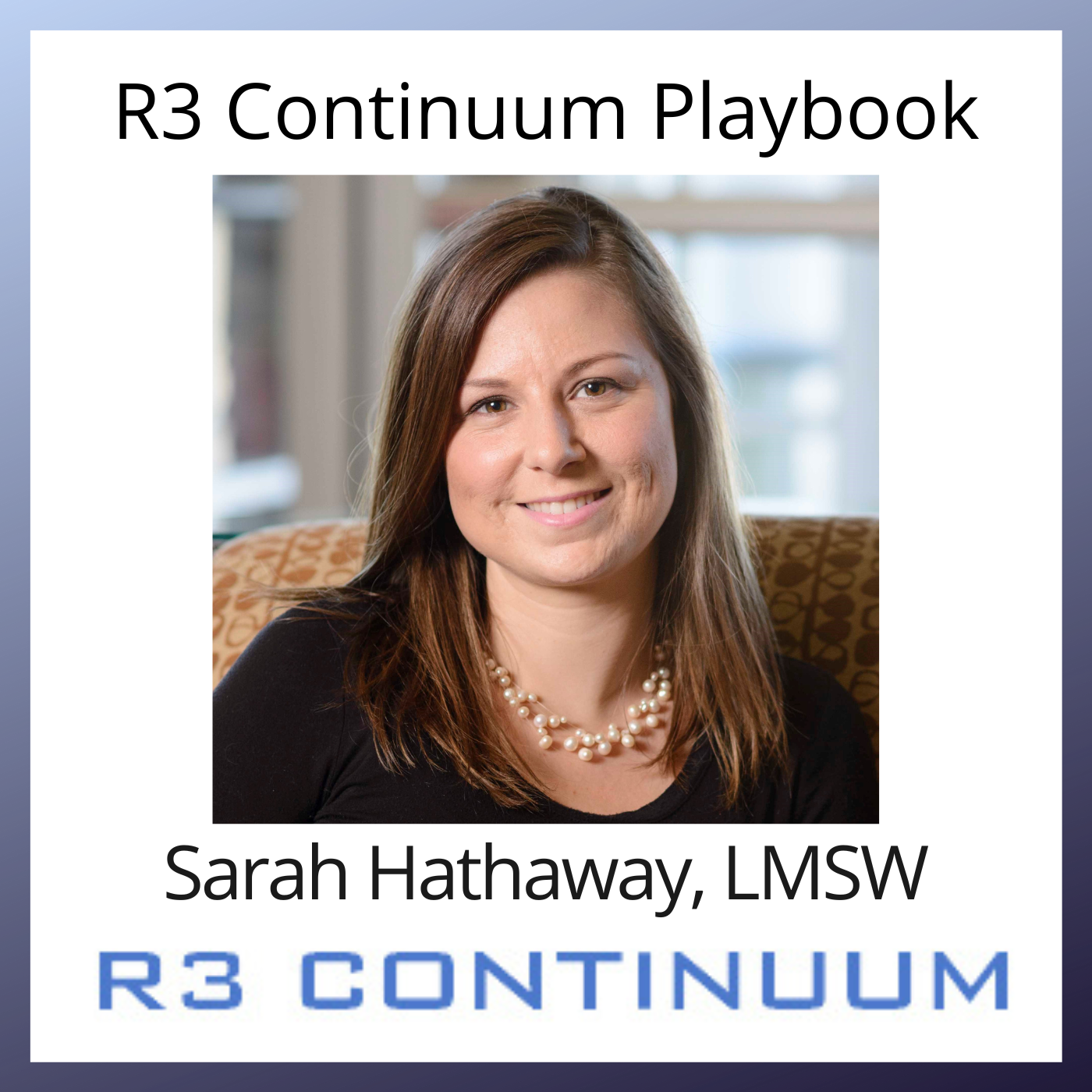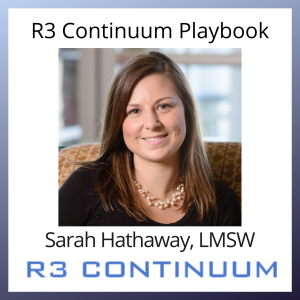
The R3 Continuum Playbook: Empowering Yourself: How You Can Be a Catalyst for Change in the Workplace
How do you go about discussing difficult topics with your company’s leadership? How can you effectively advocate for causes which you are passionate about? R3 Continuum’s Associate Director of Strategic Solutions, Sarah Hathaway, discussed these questions and more as she addressed how to become a catalyst for change within your workplace.
The full webinar from which this excerpt was taken can be found here.
The R3 Continuum Playbook is presented by R3 Continuum and is produced by the Minneapolis-St.Paul Studio of Business RadioX®. R3 Continuum is the underwriter of Workplace MVP, the show which celebrates heroes in the workplace.
TRANSCRIPT
Intro: [00:00:00] Broadcasting from the Business RadioX Studios, here is your R3 Continuum Playbook. Brought to you by workplace MVP sponsor R3 Continuum, a global leader in workplace behavioral health, crisis, and security solutions.
Shane McNally: [00:00:14] Hi, everyone. My name is Shane McNally, Digital Marketing Project Lead at R3 Continuum. On this episode of The R3 Continuum Playbook, we’ll be featuring a segment from a recent webinar presented by R3 Continuum Associate Director of Strategic Solutions, Sarah Hathaway. This recent webinar is titled Empowering Yourself, How You Can Be a Catalyst for Change in the Workplace.
Shane McNally: [00:00:35] In this short segment from her webinar, Sarah talks about how employees can become workplace champions and create a more positive culture in their workplace by utilizing the strategies she outlines.
Shane McNally: [00:00:47] So, I think let’s move forward and kind of go over what are some actual strategies to go about creating change.
Sarah Hathaway: [00:00:55] Yes. And, you really led into some of these specific points. The first one is identifying your allies. So, who is most likely to be in alignment with me on this change? And then, also your obstacles. Who are the people that are probably not going to be on board right away?
Sarah Hathaway: [00:01:15] Now, when I say obstacles, this doesn’t mean that these people are just a problem to be solved but they may present some barriers and we want to be aware of those barriers so that we can start to identify, okay, how do I address that challenge. This person has a very different viewpoint than me or this person is really committed to the status quo. What might influence them toward this change or what’s important to them? And why is the status quo important?
Sarah Hathaway: [00:01:45] So, that’s where – the next step is, just really getting the perspectives of other people. Our viewpoint may not be the right viewpoint, and maybe there’s not only one right viewpoint. Maybe, there are reasons that these other views are important, too. So we want to do a little bit of perspective-taking to really understand where is everyone else at. Are people really motivated for this change? Do they see the need that you see, or are there other things driving their perspective, other things of importance to them?
Sarah Hathaway: [00:02:16] So, you really want to tap into that motivation of what’s important and recognize, again that that may not be the same for everyone. So, for some people it might be a really passion-driven change of this is important, you know, for the well-being of our company, for the well-being of our employees, while others may be a little bit more methodical about their decision making. And so it might be a business-driven choice of, well, this is going to drive profits or reduce costs, and the return on investment is really important. So what’s that individual’s motivation or what’s the group motivation? And be able to tap into those different areas and what motivates individual people.
Sarah Hathaway: [00:03:04] Now, I mentioned the idea of the status quo. There is value oftentimes in the status quo. We wouldn’t generally be in the situation that we’re in. Even if it’s not the ideal situation, we wouldn’t be dealing with a status quo if there wasn’t some purpose for it. The status quo generally serves a purpose, even if it’s just for stability and consistency. So we have to recognize that the possibility of not changing has some value, too. It helps us to really create a bit of a counterbalance there to our own plan or ideas.
Sarah Hathaway: [00:03:39] We need to get really clear in defining what’s the ask, what needs to change, and what do we need in order to affect that change, get that buy-in as we talked about, and ultimately start to identify if I can’t have all of what I want to change, if we can’t have all of this, if that’s not possible, where are the areas where we might be able to compromise? Where can we kind of pare back the goals or the plan, or where can we maybe start small to build up a little momentum toward the change?
Shane McNally: [00:04:15] So, going off of what you were just saying about kind of the different types of changes, which do you think is typically harder to gain buy-in? Would that be like a cultural change in the organization or a business change?
Sarah Hathaway: [00:04:30] You know, it could be really any of them. That’s a good question. I think cultural changes can be harder in some ways because they’re more difficult to define at times. It’s more of a sort of nebulous shift, right? Process changes are very clear. When we’re working with widgets, I can replace this widget with that one or, you know, replace the phone call here with an email. That’s very clearly defined. Those cultural shifts are a little bit more complex. It doesn’t mean that they’re impossible or that we can’t tackle those, but they’re just different.
Shane McNally: [00:05:17] Yeah. Okay. I mean, that makes complete sense, I think. Another question following this up, and we do have about 8 minutes left, so we will answer some questions if anybody in the audience has some more as well. But is this something that is like you can only do if you’re a leader or a manager in your company, or do you think that going about these strategies and trying to create change for the better of the company can be anybody in the organization?
Sarah Hathaway: [00:05:45] I think that it can be anyone within the organization. Change starts somewhere, right? Now, I think we also have to acknowledge that at the leadership level, there oftentimes is a greater opportunity for influence. There’s greater authority, ability to make decisions that you may not be able to make at another level of the organization. But everyone can influence change. It’s about sort of setting the standard being the example at times. Creating, again, creating that buy-in, building allyship in that change, and really just starting the momentum and recognizing that even those really small changes are a catalyst toward greater change.
Sarah Hathaway: [00:06:35] Sometimes when we look at having these big, lofty goals and things that we want to shift, especially when we’re talking about a cultural shift or a team shift or program design shift, these are big things. And so sometimes it can feel like, well, gosh, we’re not making any progress, or our movement is very slow, or maybe we only got this one little piece of what we wanted. But that generally if you start to kind of look from A to Z, look over a period of time, you start to see that maybe that one small change created an opportunity for another change and another change. So, never underestimate the power of momentum in making change.
Shane McNally: [00:07:20] Reducing the amount of toxicity in the workplace can help to improve the overall well-being of you, your colleagues, and the organization as a whole. If you or your employees are feeling significant amounts of stress and workplace disruption, you’re not alone. R3 Continuum can help. Connect with us and learn about our services at www.r3c.com or email us directly at info@r3c.com.
Show Underwriter
R3 Continuum (R3c) is a global leader in workplace behavioral health and security solutions. R3c helps ensure the psychological and physical safety of organizations and their people in today’s ever-changing and often unpredictable world. Through their continuum of tailored solutions, including evaluations, crisis response, executive optimization, protective services, and more, they help organizations maintain and cultivate a workplace of wellbeing so that their people can thrive. Learn more about R3c at www.r3c.com.
R3 Continuum is the underwriter of Workplace MVP, a show which celebrates the everyday heroes–Workplace Most Valuable Professionals–in human resources, risk management, security, business continuity, and the C-suite who resolutely labor for the well-being of employees in their care, readying the workplace for and planning responses to disruption.
Connect with R3 Continuum: Website | LinkedIn | Facebook | Twitter















